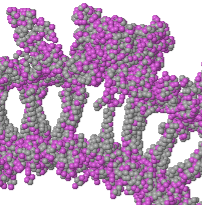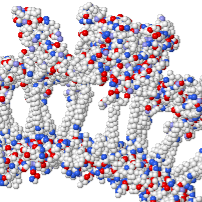|
This page describes the use of FirstGlance in Jmol version 4.0. Its release is expected soon, but it is not yet publicly available. You can test this near-final version which is also used in the FirstGlance links below, but if you upload a file it will revert to the older version of FirstGlance.
|
Virus capsids and similarly large protein assemblies can be conveniently visualized and analyzed with FirstGlance in Jmol. Below some examples are explained and illustrated, but here is a quick start: polio virus capsid in FirstGlance (1pov).
FirstGlance in Jmol automatically constructs biological unit 1, thought to be the major functional quaternary assembly. Biological unit 1 is shown initially by default, and you can start separate sessions to show the asymmetric unit or other biological units when more than one are specified. When the resulting assembly is too large to work smoothly and efficiently in FirstGlance in Jmol (all Javascript), FirstGlance will automatically simplify the model to alpha carbons, or when necessary, to a subset of alpha carbons.
Polio Virus
Polio virus is small (among viruses pathogenic for humans) with an RNA genome inside a single-shell protein capsid. 1pov
made up from 3 proteins, 60 copies of each of VP0, VP1 and VP3 (from proteolysis of polyprotein UniProt P03300). 1pov provides the structure of the 3 chains in the asymmetric unit, along with instructions for constructing the capsid (Biological Unit 1).
The polio capsid has an icosahedral construction with 12 vertices defining 20 triangular faces. Notice that the larger blue mesas protruding on the surface have 5-fold symmetry. These are pentagonal capsomeres at the 12 vertices. The capsid is composed of 180 protein chains totaling about 377K non-H atoms.
Quick Start: polio virus capsid in FirstGlance
Measuring Capsid Diameter
FirstGlance/How To Measure A Virus Capsid provides step by step instructions on how to view a slab of the capsid and measure distances.
Color Schemes
(see caption). In addition to coloring by distance from the center, or assigning a distinct color to each group of sequence-identical chains, FirstGlance offers coloring by amino to carboxy rainbow, hydrophobic vs. polar, charge, and as illustrated below, evolutionary conservation.
Hide and Isolate
Hide and Isolate tools are provided in the Focus Box of FirstGlance. Clicking on a chain offers to hide or isolate all sequence-identical chains. Here,
Similarly one can easily isolate
or
Eastern Equine Encephalitis Virus
The (EEEV) consists of 240 copies of each of three distinct protein sequences, totaling 720 chains. It has nearly 2 million non-hydrogen atoms (so about 3.8 million atoms including hydrogen). The structure 6mx4 determined by electron microscopy (4.4 Å resolution) has 12 chains, with instructions for constructing the entire capsid using 60 copies of the asymmetric unit[2].
Analyze the EEEV capsid 6mx4 in FirstGlance
Double-Shelled Capsid
Immediately you can see that this is a double-layered capsid, with outer and inner shells. Between the shells are transmembrane alpha helical "spikes" or "posts" embedded in a lipid bilayer (not represented by any atoms here).
FirstGlance/How To Measure A Virus Capsid provides step by step instructions on how to view a slab of the capsid and measure distances.
The inside diameter is about 315 Å. The length of the transmembrane spikes/posts is about 35 Å, consistent with the thickness of a lipid bilayer.
(total 720 protein chains).
Transmembrane Posts
When all ~242K alpha carbons (rather than every 10th) are displayed in FirstGlance, performance is sluggish,
but more color schemes can be meaningfully applied.
Coloring alpha carbons in a slab by Hydrophobic, Polar reveals that the transmembrane posts are largely hydrophobic.
So, as expected, coloring the slab alpha carbons by charge
Anionic (-) / Cationic (+)
shows the posts to be nearly devoid of charges.
Clathrin Cage
(In preparation.)
Vault Nanocompartment
occurs in eukaryotes.
It is about 650 Å long and 380 Å wide.
Its function is unknown[1]. The vault is composed of 78 copies of a single protein sequence.
Bacterial Gas Vesicle
(In preparation.)


